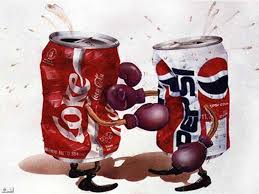But his masterstroke was the all-out marketing blitz against Coca-Cola, long the global market leader in non-alcoholic beverages. The two firms had competed for decades, but they mostly fought low-grade battles. Mr Kendall changed that, by forcing both companies into an advertising arms race. In 1975 Coca-Cola spent around $25m on advertising and PepsiCo some $18m. By 1985 those figures had shot up to $72m and $57m, respectively. In 1995 Pepsi outspent Coke by $112m to $82m.
但他的绝招是针对可口可乐发动营销闪电战,后者长期以来一直是无酒精饮料市场的领导者。这两家公司已经竞争了几十年,但大多是低级别的较量。肯德尔通过迫使两家公司进入广告军备竞赛,扭转了这一局面。1975年,可口可乐公司花费约2500万美元用于广告宣传,百事可乐花掉了大约1800万美元。到了1985年,两家广告费各自飙升至7200万美元和5700万美元。1995年,百事可乐的广告费为1.12亿美元,超过了可口可乐的8200万美元。
This was a risky gambit for both cola rivals. But it paid off in two ways. First, it helped fizzy drinks win a greater “share of throat” (a term coined by Roberto Goizueta, a former boss of Coca-Cola, who died in 1997). They went from 12.4% of American beverage consumption in 1970 to 22.4% in 1985. And though Coca-Cola maintained its lead in that period, with over a third of the market, PepsiCo’s share shot up from 20% to a peak of over 30% in the 1990s. Last year carbonated-drinks sales totalled $77bn in America, and over $312bn globally. Coca- Cola and PepsiCo remain dominant.
这对两家可乐公司来说都是冒险之举。但同时也带来了两大好处。首先,它帮助汽水饮料赢得了更大的“喉咙份额”(这是由1997年去世的可口可乐公司前老板罗伯特·戈依苏埃塔发明的术语)。1970年,汽水饮料占美国饮料销量的12.4%,而到1985年则上升至22.4%。在20世纪90年代,尽管可口可乐公司以超过三分之一的市场份额保持了当时的领先地位,但百事可乐公司的市场份额从20%骤升至峰值30%以上。去年,碳酸饮料在美国的销售额达到770亿美元,全球总销售额达到3120亿美元。可口可乐和百事可乐依旧占主导地位。

The second way that the cola wars benefited both companies was by turning them into “the world’s best marketers”, observes Kaumil Gajrawala of Credit Suisse, a bank. Today a decades-long obsession with cutprice volume growth has been replaced by a focus on revenues and profits.
瑞士信贷银行的考米尔·格拉瓦拉认为,可乐大战使两家公司受益的第二个方面是,它令两家公司都变成“世界最好的营销企业”。如今,数十年来对降价销量增长的痴迷已被对收入和利润的关注所取代。
PepsiCo in particular has relinquished some of the soft-drinks market, where its share has fallen back down to a quarter (see chart 1). But its marketing magic continues to sparkle, even if it is deployed to sell less sugary alternatives such as bottled water, coffee and energy drinks to health-conscious consumers. And over the past 40 years PepsiCo has returned nearly a third more to shareholders than Coca-Cola has.
尤其是百事可乐公司已经放弃了部分软饮料市场,其在该市场的份额已回落至四分之一。即使百事公司只面向注重健康的消费者销售低糖替代品,如瓶装水、咖啡和能量饮料,但它的销售魔力仍旧闪耀。在过去的40年里,百事公司给予股东的回报比可口可乐多出近三分之一。
In many industries a cosy duopoly retards innovation and harms consumers. The happy outcome of the cola wars has been the exact opposite. As Mr Kendall himself observed, “If there wasn’t a Coca- Cola, we would have had to invent one, and they would have had to invent Pepsi.”
在许多产业中,密切的双寡头垄断阻碍了创新,并损害了消费者。而可乐大战的结果则恰好相反。正如肯德尔先生自己所观察到的那样:“如果没有可口可乐公司,我们也要创造一个,而可口可乐也必须创造出百事可乐公司。”
译文由可可原创,仅供学习交流使用,未经许可请勿转载。












